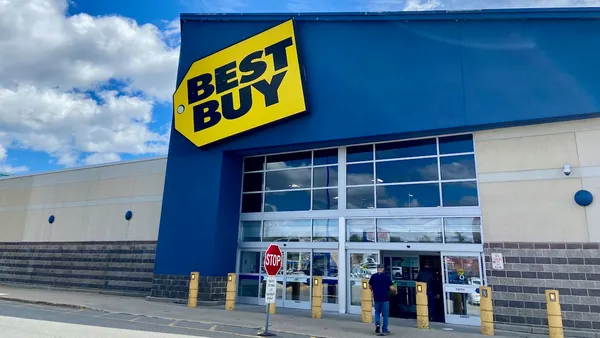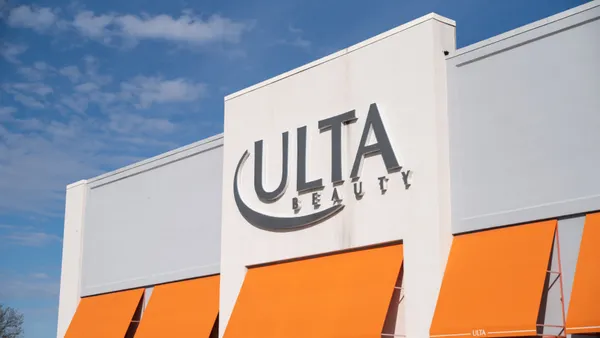Update: September 6, 2018: U.S. Senator Bernie Sanders on Wednesday introduced a bill that would tax corporations with more than 500 employees for the full amount employees receive in government assistance. The bill's title, "Stop Bad Employers by Zeroing Out Subsidies Act," or "Stop BEZOS," is an open jab at Amazon CEO Jeff Bezos. Sanders had previously criticized Amazon after a study found that some fulfillment center employees relied on a federal food assistance program. Sanders' criticism drew a heated response from Amazon, which prompted another detailed critique from Sanders' office, one that included testimonials from Amazon employees about working conditions.
Dive Brief:
-
U.S. Senator Bernie Sanders last week began circulating a petition addressed to Jeff Bezos, urging Amazon's CEO to improve working conditions and wages at its warehouses. The Vermont senator is also slated to introduce a bill to the senate on Sept. 5 that would impose a 100% tax on government benefits received by employees at companies with more than 500 people. The move would follow reports that many of Amazon's warehouse workers rely on federal assistance for food purchases.
-
In an emailed statement, an Amazon spokesperson urged consumers to compare its pay and benefits to other retailers. The company told Retail Dive it pays full-time warehouse workers $15 an hour before overtime and offers full benefits packages. While 90% of Amazon workers across jobs are full-time, according to the company, the spokesperson could not disclose to Retail Dive how many part-time employees work in its warehouses.
-
Amazon also came under fire on Twitter last week for deploying at least 16 "fulfillment center ambassadors" on the social media platform to calm conversations regarding labor practices at Amazon. The company clarified to multiple media outlets that the accounts did not belong to bots, but real people.
Dive Insight:
This is far from the first time the retail giant's labor practices have been called into question by Senator Sanders and many others.
On Prime Day 2018, Amazon's largest shopping day, Sanders held a town hall in which he invited CEOs from some of the largest corporations, including Amazon and Walmart, as well as workers, to talk about working conditions. Neither Jeff Bezos, Walmart's Doug McMillon — nor any other CEO — attended the event. But the workers painted a grim picture of employees struggling to make ends meet while keeping up with the demands of the job.
Through his upcoming bill, Sanders aims to force corporations to pay a livable wage in hopes that it curbs $150 billion in taxpayer money funding federal assistance programs, according to The Washington Post.
In Amazon's letter to shareholders in April, the company disclosed that the median salary across the board at Amazon is just $28,445 a year. Despite the company's reputation as a tech disruptor, most of the people it employs are not engineers, but warehouse workers that fuel its e-commerce delivery ambitions. Amazon employs 560,000 people globally and anticipates hiring 50,000 workers for its new headquarters. Not all employees are scraping by. If you look at salary data at the corporate level, the average salary at Amazon is $153,320, with salaries ranging from $107,749 at the 25th percentile to $185,099 at the 75th percentile, according to salary tracking site Paysa.
Working conditions specifically at warehouses have come under the spotlight recently. Earlier this year, the company was awarded patents for wristbands that track warehouse employee's hands in real time. Amazon denies it's headed toward a dystopian future, refuting that the company tracks or intends to track the location of its associates. "We develop and implement innovative technologies in our operations to enable an incredible customer experience and to enhance the safety and ergonomics of our processes," an Amazon spokesperson said in a statement emailed to Retail Dive.
But in an interview, Mark Meinster, executive director at Warehouse Worker Justice Center, told Retail Dive, "Amazon likes to talk about how they're revolutionizing retail, but it more or less adopted the Walmart model for how to run a warehouse and in some ways it's worse than Walmart," he said.
"What workers talk about more than anything is how much they are harassed by managers to make rate," Meinster said. "What Amazon has been able to do is use individual employee tracking and data to get workers to work as fast as possible. It's a very difficult job, turnover is really high."













